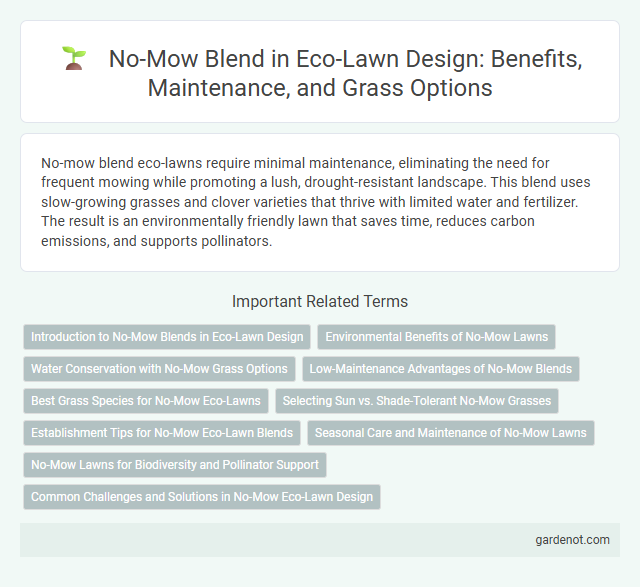No-mow blend eco-lawns require minimal maintenance, eliminating the need for frequent mowing while promoting a lush, drought-resistant landscape. This blend uses slow-growing grasses and clover varieties that thrive with limited water and fertilizer. The result is an environmentally friendly lawn that saves time, reduces carbon emissions, and supports pollinators.
Introduction to No-Mow Blends in Eco-Lawn Design
No-mow blends in eco-lawn design consist of low-growing, drought-tolerant grass varieties requiring minimal to no mowing, significantly reducing maintenance efforts and environmental impact. These blends often include fine fescues and microclover, promoting biodiversity while conserving water and reducing carbon emissions from lawn equipment. Incorporating no-mow blends enhances sustainability by supporting pollinator habitats and improving soil health within residential and commercial landscapes.
Environmental Benefits of No-Mow Lawns
No-mow lawn blends significantly reduce water consumption by eliminating the need for frequent irrigation, contributing to sustainable water management. These grasses promote biodiversity by providing habitat for pollinators and beneficial insects, enhancing local ecosystems. Reduced lawn maintenance lowers fossil fuel emissions from mowing equipment, supporting cleaner air quality and lowering carbon footprints.
Water Conservation with No-Mow Grass Options
No-mow grass blends significantly reduce water consumption by minimizing irrigation needs, making them ideal for eco-friendly landscaping focused on water conservation. These drought-tolerant grasses maintain vibrant green coverage without frequent mowing or watering, optimizing resource efficiency and supporting sustainable yard care. Implementing no-mow turf options helps lower water bills and conserves local water supplies, promoting environmental stewardship.
Low-Maintenance Advantages of No-Mow Blends
No-mow blends drastically reduce lawn maintenance by eliminating the need for regular mowing, saving time and effort. These eco-friendly blends promote drought tolerance and improve soil health, requiring less water and fewer fertilizers. Their dense growth also suppresses weeds naturally, minimizing the need for chemical treatments.
Best Grass Species for No-Mow Eco-Lawns
Fine fescues, including hard fescue, chewings fescue, and creeping red fescue, are the best grass species for no-mow eco-lawns due to their drought tolerance and low growth rate. These grasses require minimal maintenance and thrive in shaded or low-fertility soils, making them ideal for sustainable lawns. Incorporating fine fescues into a no-mow blend promotes water conservation and reduces the need for frequent mowing, enhancing eco-friendly lawn care.
Selecting Sun vs. Shade-Tolerant No-Mow Grasses
Selecting the right no-mow grass blend depends on light exposure, with sun-tolerant varieties like fine fescues thriving in full sun and shade-tolerant mixes containing red fescue and creeping red fescue performing well in shaded areas. Sun-tolerant no-mow grasses exhibit drought resistance and dense growth, reducing the need for frequent maintenance. Shade-tolerant blends enhance soil stabilization and promote biodiversity in low-light environments, making them ideal for wooded or partially shaded yards.
Establishment Tips for No-Mow Eco-Lawn Blends
Establishing a no-mow eco-lawn blend requires selecting drought-tolerant, native grass species such as fine fescues and clover to ensure low maintenance and resilience. Optimal soil preparation includes testing pH levels and incorporating organic compost to enhance nutrient availability and promote deep root growth. Consistent watering during the initial 4-6 weeks aids seed germination, while avoiding early mowing encourages robust establishment and a sustainable, weed-resistant lawn.
Seasonal Care and Maintenance of No-Mow Lawns
No-mow blend lawns require minimal maintenance, thriving with seasonal care such as light watering during dry periods and occasional overseeding in early spring to maintain dense coverage. These blends typically consist of fine fescues and native grasses that resist weeds and reduce lawn diseases, promoting a sustainable, low-impact landscape. Proper seasonal upkeep ensures a healthy, drought-tolerant lawn that supports biodiversity and reduces environmental footprint.
No-Mow Lawns for Biodiversity and Pollinator Support
No-mow lawn blends create low-maintenance landscapes that enhance biodiversity by providing essential habitats for pollinators like bees and butterflies. These blends typically include native grasses and wildflowers that require minimal mowing, encouraging a thriving ecosystem. Supporting no-mow lawns contributes to ecological balance, soil health, and the conservation of vital pollinator species.
Common Challenges and Solutions in No-Mow Eco-Lawn Design
No-mow eco-lawn designs often face challenges such as uneven growth, weed intrusion, and inadequate ground coverage, which can affect aesthetic appeal and durability. Selecting a carefully balanced no-mow blend with drought-tolerant, shade-adapted species like fine fescues and native clovers helps mitigate these issues by promoting dense turf and natural weed suppression. Implementing site-specific soil amendments and optimized mowing height guidelines supports healthier root systems and reduces maintenance needs in no-mow eco-lawns.
No-mow blend Infographic

 gardenot.com
gardenot.com